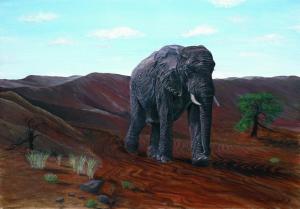Sale on canvas prints! Use code ABCXYZ at checkout for a special discount!

Elephants have a profound impact on the health of their surrounding environment, whether in the Mali Desert or as they once did in Nyungwe National Park. Their paths create natural firebreaks and water conduits, shaping the landscape and providing the necessary conditions for many plants and animals. In dry riverbeds, the water holes they dig provide water to other species. Their feces serve as a valuable nutrient source and seed disseminator. Through their fecal matter, elephants perform a role in the conversion of savannah and woodlands to grasslands, as seeds are carried through their fecal matter, which is carried underground by insects. The sheer size of the elephants disturbs the inhabitants of the ground, including amphibians, insects, and reptiles. This provides food for birds.
In Nyungwe National Park, a good example of the interdependency of organisms lies in the relationship between elephants and gorillas. The disappearance of elephants following the rise in poaching in the 1990s had a profoundly negative impact on the gorillas in the region. The reason for this was that the elephant would consume and trample the climbing vine, sericostachys scandens, preventing its overgrowth. In the absence of the elephants, the climbing vine was able to grow unabated, preventing the plants that the gorillas consume from growing. These areas are now unsuitable for the gorillas.
The lack of elephants has a cascading impact on the ecosystem. Without the elephant to consume and trample the climbing vine, there has been an absence of large ungulates such as giraffes (hoofed animals) as well as grazing animals which would normally prevent excessive ferns and grass from growing. In turn, this has hampered forest regeneration, as seed dispersal and germination is thwarted. By breaking trees apart, elephants provide food for termites, homes for ants, and resin for native bees, which play a vital role in pollination.
Shifting weather patterns as a result of global warming trends continues to threaten the desert elephants of the Mali desert. The migration of the desert elephant is intimately linked to the water cycle. If the range of the elephants shrinks, so too does the available foliage, as resources are used more intensely. Around the globe, since the 1970s, drought-stricken land area has more than doubled. To find water, these elephants migrate almost 300 miles per year, up to 35 miles a day. Their powerful memory allows them to locate places they havenít been to in decades. Likewise for local people, traditional housing, which employed bush timber, is no longer possible as a result of deforestation and climate change. Competition for dwindling water resources poses a problem for all.
There are a number of ways you can help. Taking ownership can start at your own household level in the mitigation of your environmental impact, and extend all the way to more direct aid with such organizations as The Mali Elephant Project, which is dedicated to the protection of these elephants. This group has partnered with a Kenyan organization called Save the Elephants, as well as the Malian government to provide public outreach, political advocacy, and scientific research.